Construction of High-Load-Bearing Capacity Polyamide-Imide Self-Lubricating Coatings with Various Nanoparticles Through Worn Surface of Cobblestone-like Road
Abstract
1. Introduction
2. Materials and Methods
2.1. Materials
2.2. Preparation of Composite Coatings
2.3. Tribology Tests
2.4. Characterization Methods
3. Results and Discussion
3.1. Characterization of SiO2 Morphology and Structure
3.2. Tribological Properties Under Different Lubrication Conditions
3.3. Wear Surface Morphology Analysis
4. Conclusions
- The presence of -NH2- groups on the SiO2 surface, which can be embedded into the PAI coating during the curing process, synergistically enhances the surface hardness of the coating when combined with SCF and BN nanofillers. The PBSF composite coating demonstrates a 29% improvement in surface hardness compared to the pure PAI coating.
- Friction experiments demonstrate that the nanofillers significantly enhance the stability of the coefficient of friction and the load-carrying capacity of the PAI coatings, achieving a load-bearing capacity exceeding 1000 N. Furthermore, the energy-efficient repair additive CeO2 further improves the friction reduction performance of the coatings, exhibiting the most effective friction reduction under high-load conditions. The PBSF composite coatings exhibit the lowest coefficient of friction of 0.04 under CW + CeO2 lubrication conditions, with a wear rate of 0.41 × 10−8 mm3/N·m.
- The wear mechanism of PBSF under CW + CeO2 lubrication conditions reveals that CeO2 forms a cobblestone-like overlayer on the coating surface under the influence of gravity and frictional shear forces, which partially bears the load and reduces stress concentration on SCF. Additionally, a portion of the PAI matrix and the lubricating medium form a tribofilm on the steel ring surface. The synergistic interaction of the cobblestone-like CeO2 overlayer, SCF, and tribofilm provides the PBSF composite coating with exceptional friction reduction, wear resistance, and high load-bearing performance.
Author Contributions
Funding
Institutional Review Board Statement
Informed Consent Statement
Data Availability Statement
Conflicts of Interest
References
- Zhang, Y.; Zhang, D.; Wei, X.; Zhong, S.; Wang, J. Enhanced tribological properties of polymer composite coating containing graphene at room and elevated temperatures. Coatings 2018, 8, 91. [Google Scholar] [CrossRef]
- Tavakoli, S.; Nemati, S.; Kharaziha, M.; Akbari-Alavijeh, S. Embedding CuO nanoparticles in PDMS-SiO2 coating to improve antibacterial characteristic and corrosion resistance. Colloid Interface Sci. Commun. 2019, 28, 20–28. [Google Scholar] [CrossRef]
- Zhang, Z.; Yang, M.; Yuan, J.; Guo, F.; Men, X. Friction and wear behaviors of MoS2-multi-walled carbon nanotube hybrid reinforced polyurethane composite coating. Friction 2018, 7, 316–326. [Google Scholar] [CrossRef]
- Naderi-Samani, H.; Shoja Razavi, R.; Loghman-Estarki, M.R.; Ramazani, M.; Barekat, M.; Mishra, A.K.; Fattahi, H. The effects of Cloisite 20A content on the adhesion strength and corrosion behavior of poly(amide-imide)/cloisite 20A nanocomposite coatings. Compos. Part B Eng. 2019, 175, 107154. [Google Scholar] [CrossRef]
- Xi, Z.; Wan, H.; Chen, L.; Zhou, H.; Chen, J. Strengthening mechanism of in-situ synthesized Cu2S nanoparticles on tribological performance of polyamide-imide bonded solid lubricating coatings. Prog. Org. Coat. 2022, 166, 106807. [Google Scholar] [CrossRef]
- Li, G.; Ma, Y.; Wan, H.; Chen, L.; An, Y.; Ye, Y.; Zhou, H.; Chen, J. Flake aluminum reinforced polyamideimide-polytetrafluoroethylene bonded solid lubricating composite coating for wear resistance and corrosion protection. Eur. Polym. J. 2021, 152, 110485. [Google Scholar] [CrossRef]
- Wu, J.; Yin, X.; Mu, L.; Feng, X.; Lu, X.; Shi, Y. Hollow IF-MoS2/r-GO nanocomposite filled polyimide coating with improved mechanical, thermal and tribological properties. Coatings 2020, 11, 25. [Google Scholar] [CrossRef]
- Li, B.; Jiang, X.; Wan, H.; Chen, L.; Ye, Y.; Zhou, H.; Chen, J. Optimum hydrophilic modification of lanthanum trifluoride nanoparticles and their application in enhancing tribological properties of eco-friendly water-based bonded solid lubricating coatings. Tribol. Int. 2018, 125, 1–11. [Google Scholar] [CrossRef]
- Kesler, D.; Ariyawansa, B.P.; Rathnayake, H. Mechanical Properties and Synergistic Interfacial Interactions of ZnO Nanorod-Reinforced Polyamide–Imide Composites. Polymers 2023, 15, 1522. [Google Scholar] [CrossRef]
- Wu, Y.; Wu, R.; Zhou, X.; Wang, H.; Hu, Y.; Nie, D.; Bao, D. Numerical modelling on the effect of temperature on MOCVD growth of ZnO using diethylzinc and tertiarybutanol. Coatings 2022, 12, 1991. [Google Scholar] [CrossRef]
- Fan, L.; Cao, J.; Suo, X.; Liu, L.; Xu, H.; Wang, S. The Tribological properties of polyimide/polyamide-imide/epoxy coating filled by WS2 and ZnO under dry, water, and sediment conditions. J. Macromol. Sci. Part B 2023, 63, 242–259. [Google Scholar] [CrossRef]
- Qi, H.; Zhang, G.; Zheng, Z.; Yu, J.; Hu, C. Tribological properties of polyimide composites reinforced with fibers rubbing against Al2O3. Friction 2020, 9, 301–314. [Google Scholar] [CrossRef]
- Cao, J.; Wang, Y.; Liu, G.; Shang, Q.; Wang, B.; Sun, J.; Bai, Y.; Liu, M.; Yu, F.; Ma, G.; et al. Surface modification of nano-Al2O3 with silane coupling agent and its effect on the compressive strength of PI/Al2O3 Composites. Coatings 2023, 14, 27. [Google Scholar] [CrossRef]
- Zhao, G.; Hussainova, I.; Antonov, M.; Wang, Q.; Wang, T. Friction and wear of fiber reinforced polyimide composites. Wear 2013, 301, 122–129. [Google Scholar] [CrossRef]
- Tang, H.; Zhou, H.; Cheng, X. Friction process analysis of carbon fiber-carbon nanotube multiscale hybrid reinforced epoxy with excellent tribological performance. Tribol. Int. 2022, 171, 107559. [Google Scholar] [CrossRef]
- Yuan, H.; Yang, S.; Liu, X.; Wang, Z.; Ma, L.; Hou, K.; Yang, Z.; Wang, J. Polyimide-based lubricating coatings synergistically enhanced by MoS2@HCNF hybrid. Compos. Part A Appl. Sci. Manuf. 2017, 102, 9–17. [Google Scholar] [CrossRef]
- Saxena, M.; Sharma, A.K.; Srivastava, A.K.; Singh, R.K.; Dixit, A.R.; Nag, A.; Hloch, S. Microwave-assisted synthesis, characterization and tribological properties of a g-C3N4/MoS2 nanocomposite for low friction coatings. Coatings 2022, 12, 1840. [Google Scholar] [CrossRef]
- Yan, J.; Wu, C.; Hou, J.; Zhang, X.; Liu, Y.; Zhang, Y.; Li, P.; Che, H.; Xing, Z.; Wang, Y. Tribological properties of polyimide coatings filled with graphene oxide and MXene composite nanofillers. Tribol. Int. 2023, 189, 109000. [Google Scholar] [CrossRef]
- Tu, C.; Cao, J.; Huang, H.; Yan, C.; Al-Maqbol, A.; Wang, X. The investigation of microstructure and tribological properties of PTFE/PI-PAI composite coating added with VN. Surf. Coat. Technol. 2022, 432, 128092. [Google Scholar] [CrossRef]
- Liao, C.; Zhang, Z.; Yang, M.; Yuan, J.; Liu, M.; He, Y.; Li, P.; Jiang, W.; Liu, W. The cooperatively crosslinking between GO-COOH/TiO2 @PAO microcapsules and polyimide to improve the mechanical and tribological properties of PEEK/PI composites. Tribol. Int. 2024, 191, 109209. [Google Scholar] [CrossRef]
- Lan, J.; Mo, C.; Chen, X.; Hu, T.; Li, X.; Zhang, C. Carbon fiber/nano SiO2 reinforced polyelectrolyte-graft UHMWPE for water lubricated superlubricity. Tribol. Int. 2025, 202, 110303. [Google Scholar] [CrossRef]
- Yan, J.; Rong, Y.; Zhang, Y.; Zhou, S.; Huang, J.; Zhao, G.; Liu, Y. Wear and corrosion resistance of textured and functionally particle-enhanced multilayer dual-biomimetic polymer coatings. Tribol. Int. 2025, 202, 110335. [Google Scholar] [CrossRef]
- Chen, B.; Dong, Z.; Li, J.; Zhang, M.; Zhang, K. ZnO nanowires-decorated h-BN hybrid for enhancing the tribological properties of epoxy resin. Prog. Org. Coat. 2021, 161, 106493. [Google Scholar] [CrossRef]
- Yang, J.; Xiao, Q.; Lin, Z.; Li, Y.; Jia, X.; Song, H. Growth of ultra-dense MoS2 nanosheets on carbon fibers to improve the mechanical and tribological properties of polyimide composites. Friction 2020, 9, 1150–1162. [Google Scholar] [CrossRef]
- Song, J.; Yu, Y.; Zhao, G.; Qiu, J.; Ding, Q. Comparative study of tribological properties of insulated and conductive polyimide composites. Friction 2019, 8, 507–516. [Google Scholar] [CrossRef]
- Ye, X.; Liu, X.; Yang, Z.; Wang, Z.; Wang, H.; Wang, J.; Yang, S. Tribological properties of fluorinated graphene reinforced polyimide composite coatings under different lubricated conditions. Compos. Part A Appl. Sci. Manuf. 2016, 81, 282–288. [Google Scholar] [CrossRef]
- Yan, Q.; Ma, H.; Zhang, D.; Wen, P.; Fan, M. Oleic acid modified oxide graphene/triazine-based covalent-organic frameworks composite: Cooperation between heterostructure and electrical double layer to enhance tribological performances. Tribol. Int. 2023, 178, 108066. [Google Scholar] [CrossRef]
- Wu, B.; Song, H.; Li, C.; Song, R.; Zhang, T.; Hu, X. Enhanced tribological properties of diesel engine oil with Nano-Lanthanum hydroxide/reduced graphene oxide composites. Tribol. Int. 2020, 141, 105951. [Google Scholar] [CrossRef]
- Zhao, Z.; Ma, Y.; Wan, H.; Ye, Y.; Chen, L.; Zhou, H.; Chen, J. Preparation and tribological behaviors of polyamide-imide/polytetrafluoroethylene lubricating coatings reinforced by in-situ synthesized CeO2 nanoparticles. Polym. Test. 2021, 96, 107100. [Google Scholar] [CrossRef]
- Lei, X.; Zhang, Y.; Zhang, S.; Yang, G.; Zhang, C.; Zhang, P. Study on the mechanism of rapid formation of ultra-thick tribofilm by CeO2 nano additive and ZDDP. Friction 2022, 11, 48–63. [Google Scholar] [CrossRef]
- Ali, M.K.A.; Xianjun, H. Exploring the lubrication mechanism of CeO2 nanoparticles dispersed in engine oil by bis(2-ethylhexyl) phosphate as a novel antiwear additive. Tribol. Int. 2022, 165, 107321. [Google Scholar] [CrossRef]
- Shen, T.; Wang, D.; Yun, J.; Liu, Q.; Liu, X.; Peng, Z. Tribological properties and tribochemical analysis of nano-cerium oxide and sulfurized isobutene in titanium complex grease. Tribol. Int. 2016, 93, 332–346. [Google Scholar] [CrossRef]
- De Oliveira, P.R.; Sukumaran, A.K.; Benedetti, L.; John, D.; Stephens, K.; Chu, S.-H.; Park, C.; Agarwal, A. Novel polyimide-hexagonal boron nitride nanocomposites for synergistic improvement in tribological and radiation shielding properties. Tribol. Int. 2023, 189, 108936. [Google Scholar] [CrossRef]
- Wang, S.; Jia, F.; Wang, X.; Hu, L.; Sun, Y.; Yin, G.; Zhou, T.; Feng, Z.; Kumar, P.; Liu, B. Fabrication of ZnO Nanoparticles Modified by Uniformly Dispersed Ag Nanoparticles: Enhancement of Gas Sensing Performance. ACS Omega 2020, 5, 5209–5218. [Google Scholar] [CrossRef]
- Zhang, G.; Chang, L.; Schlarb, A.K. The roles of nano-SiO2 particles on the tribological behavior of short carbon fiber reinforced PEEK. Compos. Sci. Technol. 2009, 69, 1029–1035. [Google Scholar] [CrossRef]
- Zhang, G.; Wetzel, B.; Jim, B.; Oesterle, W. Impact of counterface topography on the formation mechanisms of nanostructured tribofilm of PEEK hybrid nanocomposites. Tribol. Int. 2015, 83, 156–165. [Google Scholar] [CrossRef]
- Lv, M.; Zheng, F.; Wang, Q.; Wang, T.; Liang, Y. Friction and wear behaviors of carbon and aramid fibers reinforced polyimide composites in simulated space environment. Tribol. Int. 2015, 92, 246–254. [Google Scholar] [CrossRef]
- Song, J.; Yu, Y.; Zhao, G.; Qiu, J.; Ding, Q. Improved tribological properties of polyimide composites by micro–nano reinforcement. J. Appl. Polym. Sci. 2019, 136, 47900. [Google Scholar] [CrossRef]
- Li, J.; Qu, J.; Zhang, Y. Wear properties of brass and PTFE–matrix composite in traveling wave ultrasonic motors. Wear 2015, 338–339, 385–393. [Google Scholar] [CrossRef]
- Shen, B.; Zhai, W.; Zheng, W. Ultrathin flexible graphene film: An excellent thermal conducting material with efficient EMI shielding. Adv. Funct. Mater. 2014, 24, 4542–4548. [Google Scholar] [CrossRef]
- Yu, P.; He, R.; Li, G.; Guo, Y.; Myshkin, N.K.; Zhang, G. Novel Nanocomposites Reinforced with Layered Double Hydroxide Platelets: Tribofilm Growth Compensating for Lubrication Insufficiency of Oil Films. ACS Sustain. Chem. Eng. 2022, 10, 4929–4942. [Google Scholar] [CrossRef]


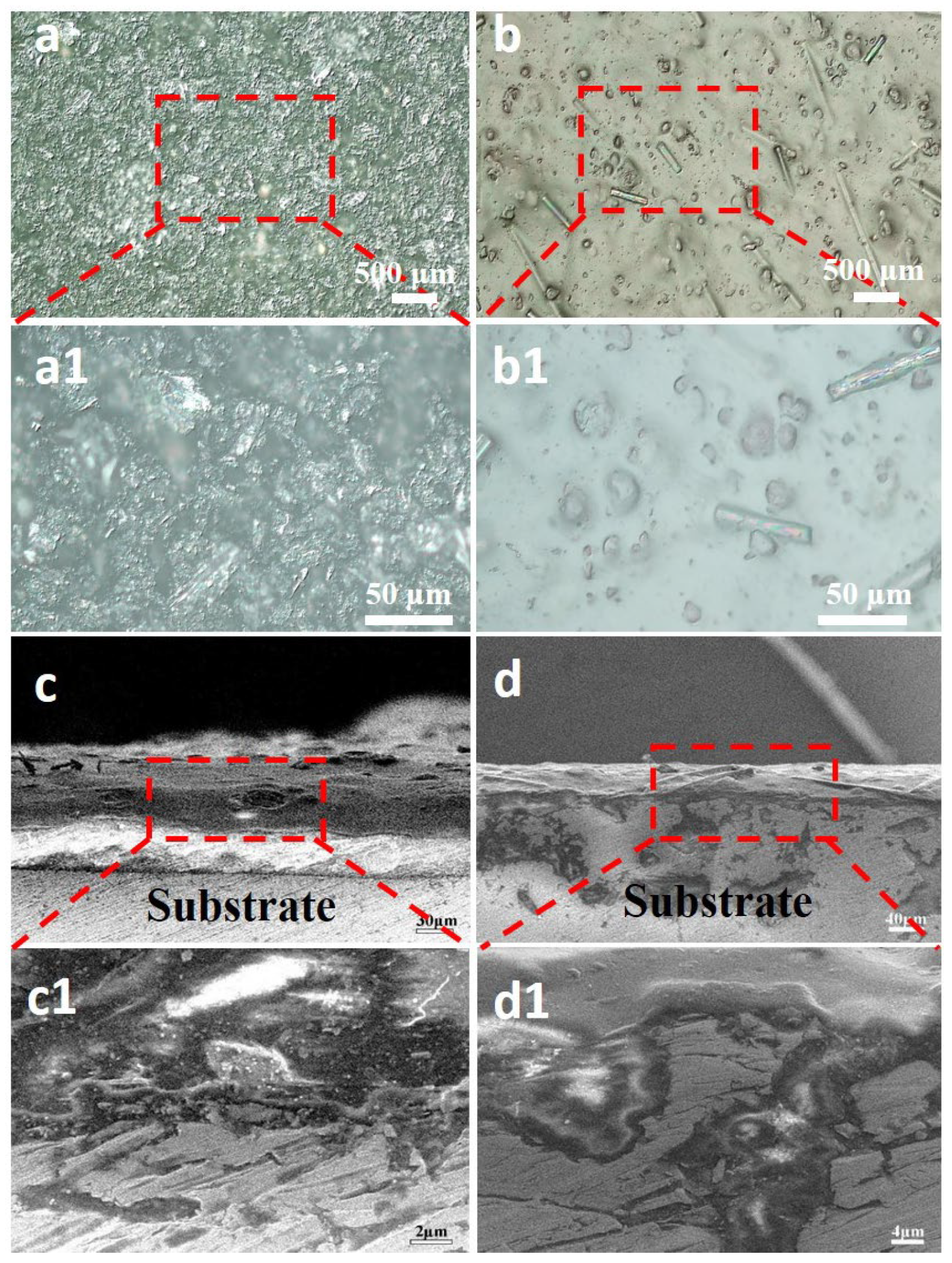
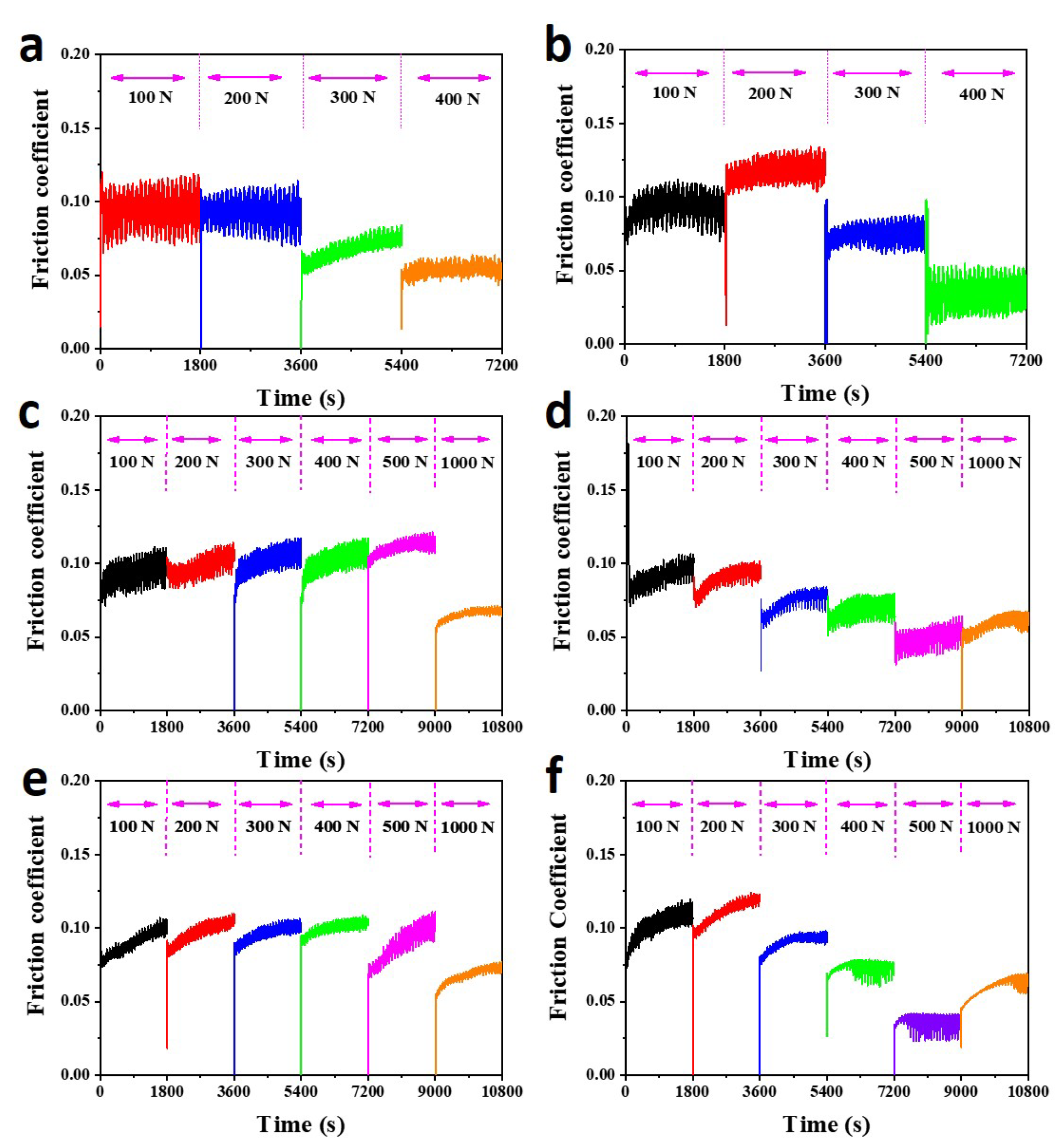

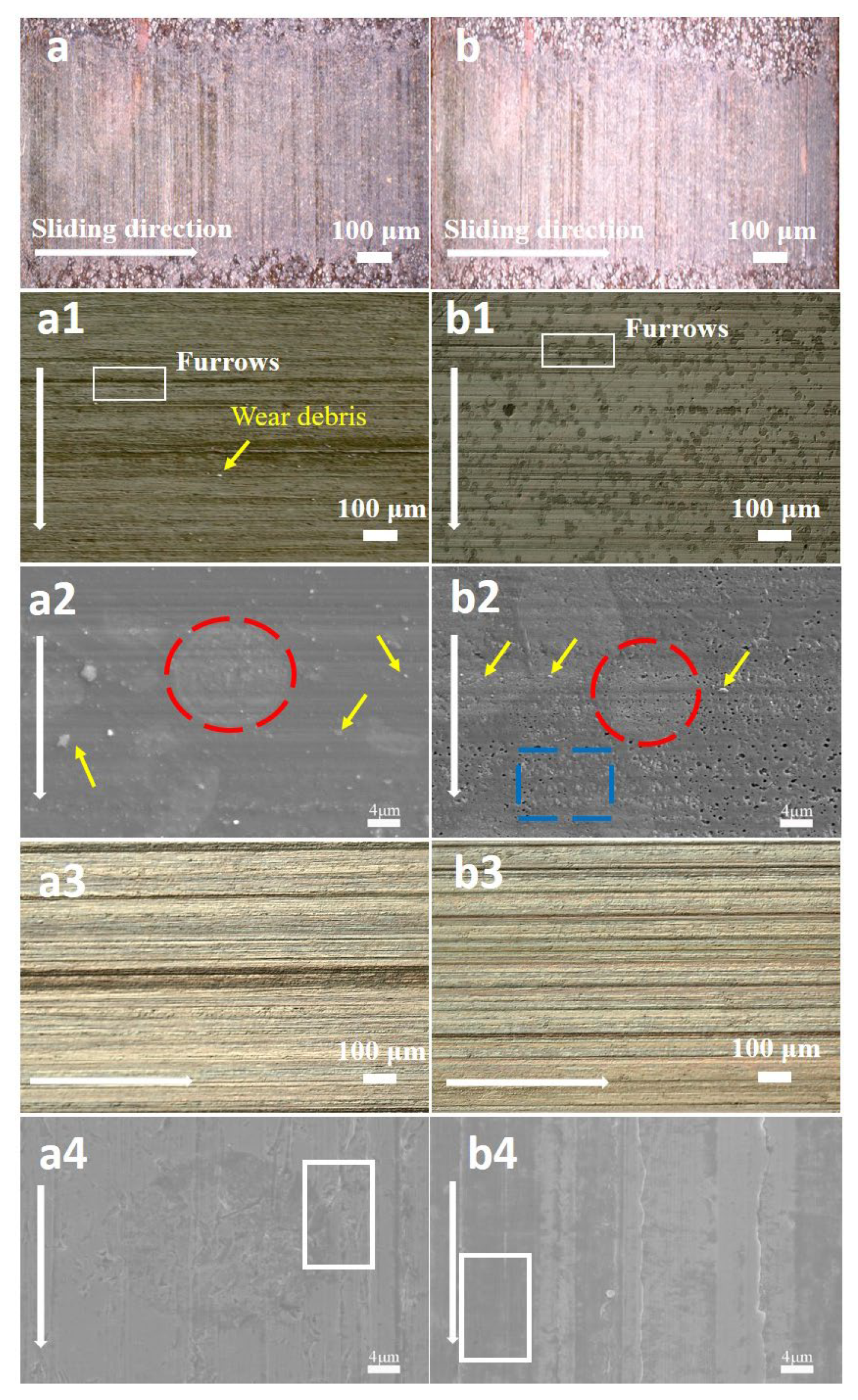
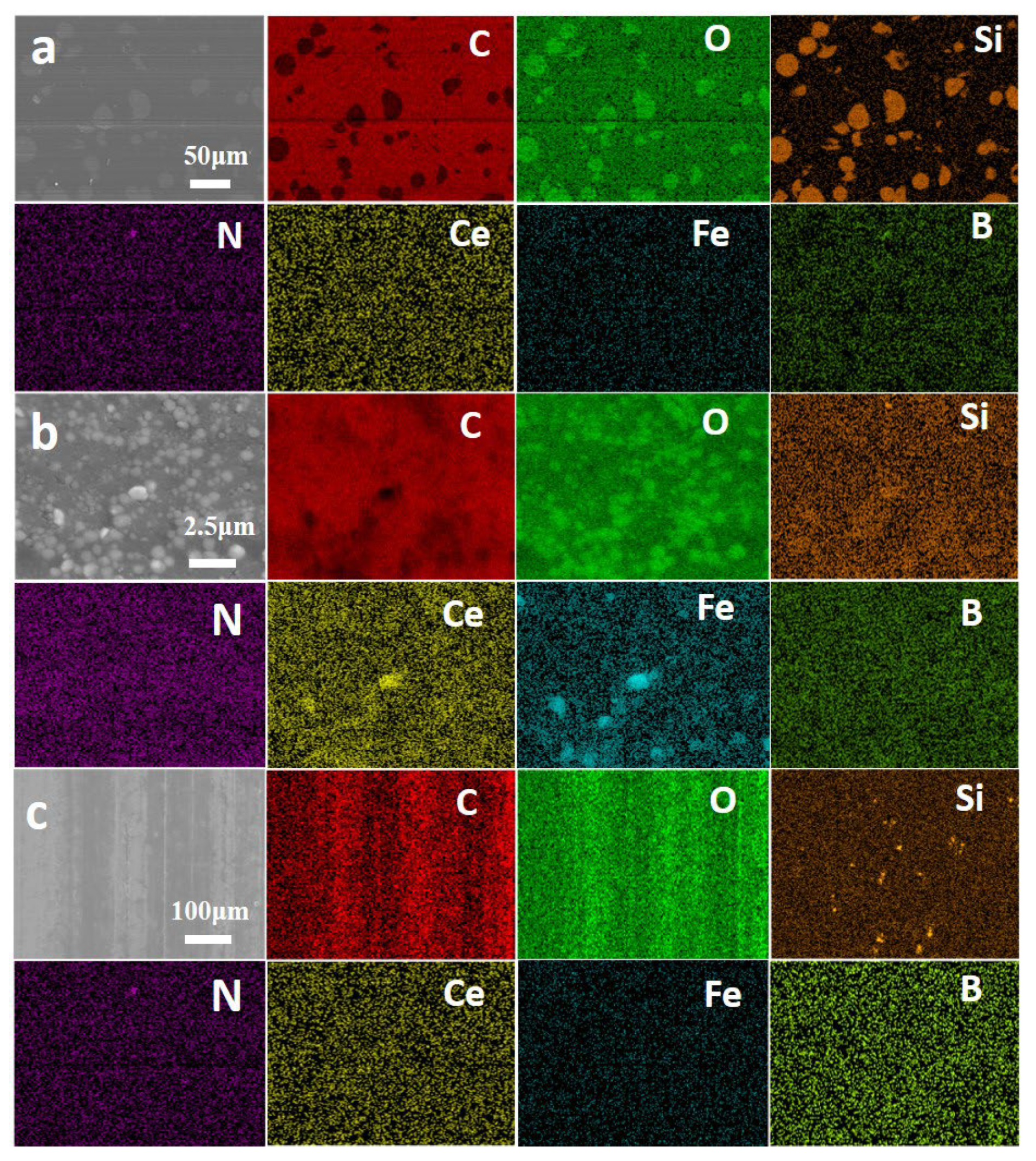



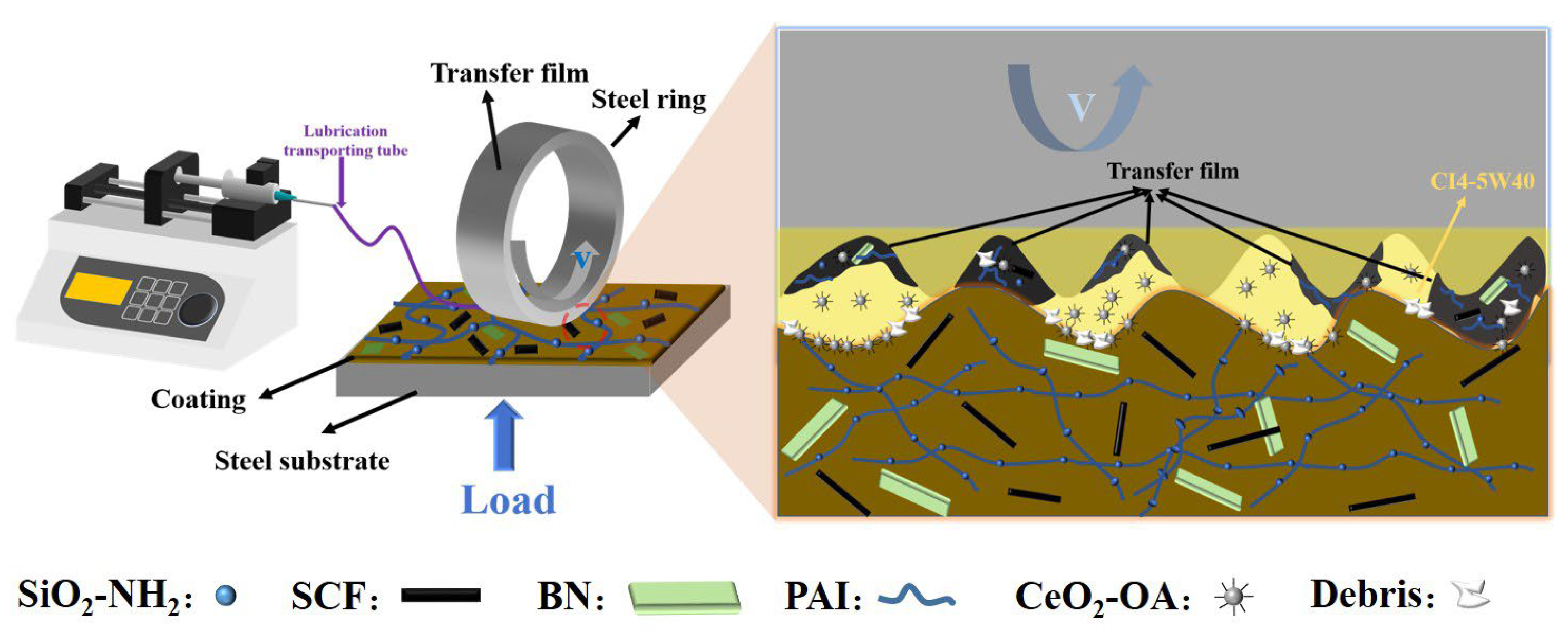
| Code | Constituent | PAI (wt.%) | BN (wt.%) | SiO2 (wt.%) | SCF (wt.%) |
|---|---|---|---|---|---|
| NP | Neat PAI | 100 | 0 | 0 | 0 |
| PBS | PAI/BN/SiO2 | 95 | 4 | 1 | 0 |
| PBSF | PAI/BN/SiO2/SCF | 85 | 4 | 1 | 10 |
| Parameter | Detailed Value | |||||
|---|---|---|---|---|---|---|
| Load (N) | 100 | 200 | 300 | 400 | 500 | 1000 |
| Stress (MPa) | 20.8 | 29.4 | 36.0 | 41.6 | 46.5 | 66.7 |
| Steel ring | GCr15, r: 25 mm, E: 210 GPa, ν: 0.30 | |||||
| Specimen block | 25.00 mm × 9.85 mm × 6.00 mm | |||||
| Lubrication condition | CW, CW + CeO2 | |||||
| Speed | 100 rev/min (0.26 m/s) | |||||
| Time | Per load 30 min | |||||
| Oil feed rate | 0.17 mL/min | |||||
| Materials | Abbreviation | Materials | Abbreviation |
|---|---|---|---|
| Short Carbon Fiber | SCF | Aluminum oxide | Al2O3 |
| Carbon Fiber | CF | Molybdenum disulfide | MoS2 |
| Short Glass Fiber | SGF | Polytetrafluoroethylene | PTFE |
| Glass Fiber | GF | Graphene oxide | GO |
| Polyimide-imide | PAI | Hexagonal boron nitride | h-BN |
| Silica | SiO2 | Polyalphaolefin 6 | PAO6 |
| Lanthanum trifluoride | LaF3 | Polyimide | PI |
| Zinc oxide | ZnO | Polyamide-imide | PAI |
Disclaimer/Publisher’s Note: The statements, opinions and data contained in all publications are solely those of the individual author(s) and contributor(s) and not of MDPI and/or the editor(s). MDPI and/or the editor(s) disclaim responsibility for any injury to people or property resulting from any ideas, methods, instructions or products referred to in the content. |
© 2025 by the authors. Licensee MDPI, Basel, Switzerland. This article is an open access article distributed under the terms and conditions of the Creative Commons Attribution (CC BY) license (https://creativecommons.org/licenses/by/4.0/).
Share and Cite
Ye, W.; Niu, M.; Bian, L.; Duan, C.; Gao, C.; Zhang, P.; Zhang, Y.; Zhang, S. Construction of High-Load-Bearing Capacity Polyamide-Imide Self-Lubricating Coatings with Various Nanoparticles Through Worn Surface of Cobblestone-like Road. Coatings 2025, 15, 338. https://doi.org/10.3390/coatings15030338
Ye W, Niu M, Bian L, Duan C, Gao C, Zhang P, Zhang Y, Zhang S. Construction of High-Load-Bearing Capacity Polyamide-Imide Self-Lubricating Coatings with Various Nanoparticles Through Worn Surface of Cobblestone-like Road. Coatings. 2025; 15(3):338. https://doi.org/10.3390/coatings15030338
Chicago/Turabian StyleYe, Wenyong, Mengchuan Niu, Lijie Bian, Chunjian Duan, Chuanping Gao, Pingyu Zhang, Yujuan Zhang, and Shengmao Zhang. 2025. "Construction of High-Load-Bearing Capacity Polyamide-Imide Self-Lubricating Coatings with Various Nanoparticles Through Worn Surface of Cobblestone-like Road" Coatings 15, no. 3: 338. https://doi.org/10.3390/coatings15030338
APA StyleYe, W., Niu, M., Bian, L., Duan, C., Gao, C., Zhang, P., Zhang, Y., & Zhang, S. (2025). Construction of High-Load-Bearing Capacity Polyamide-Imide Self-Lubricating Coatings with Various Nanoparticles Through Worn Surface of Cobblestone-like Road. Coatings, 15(3), 338. https://doi.org/10.3390/coatings15030338







